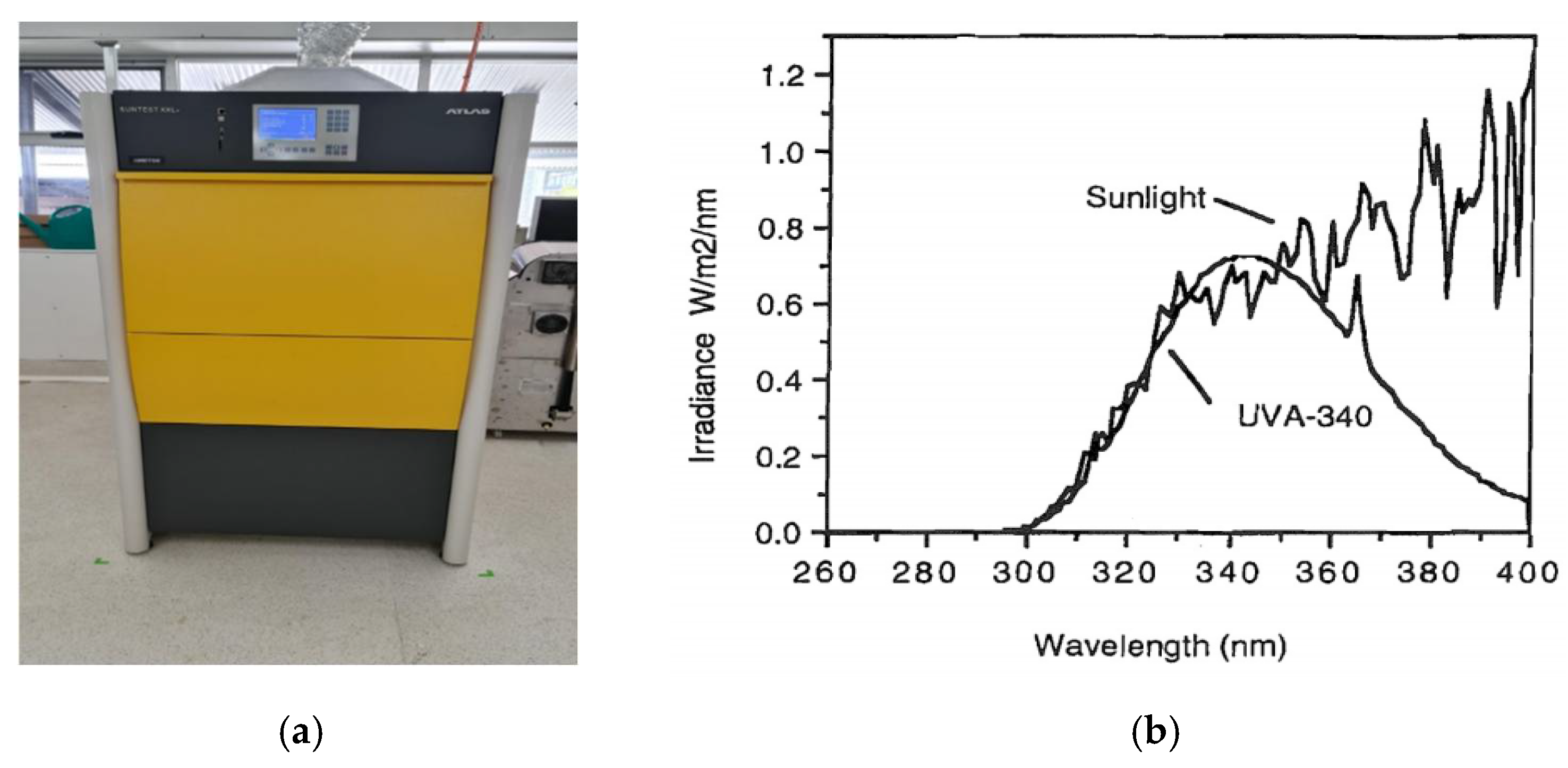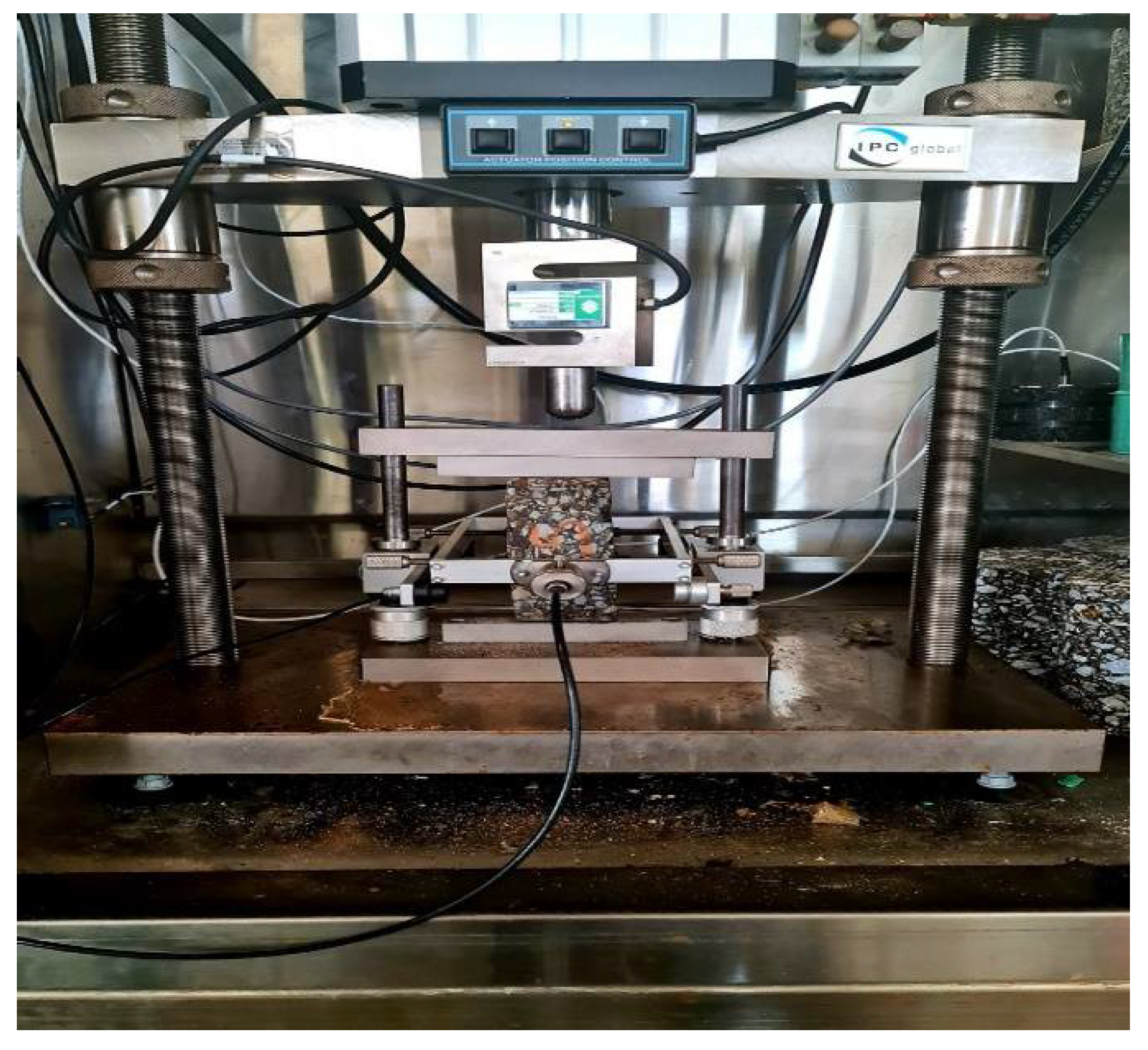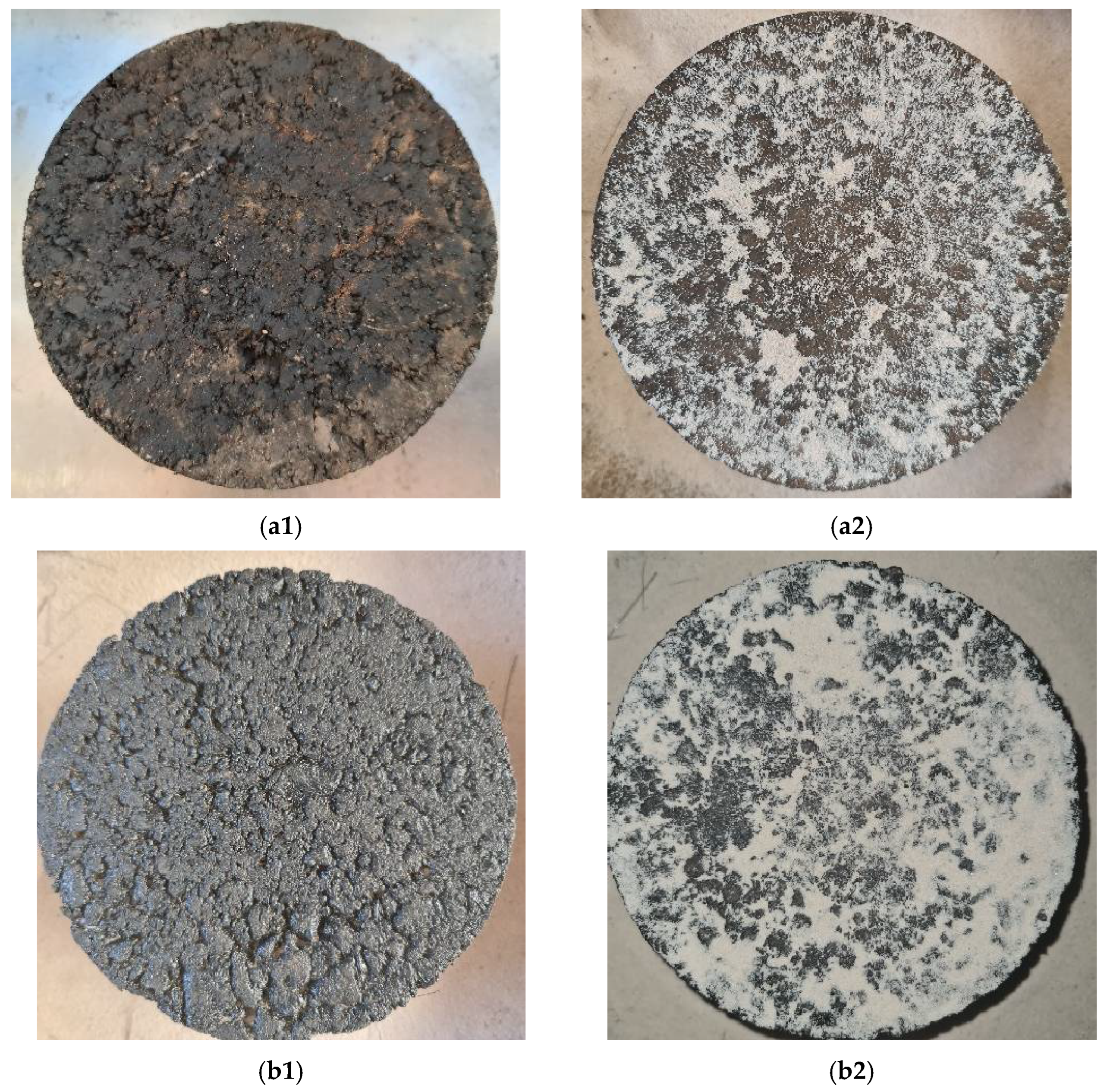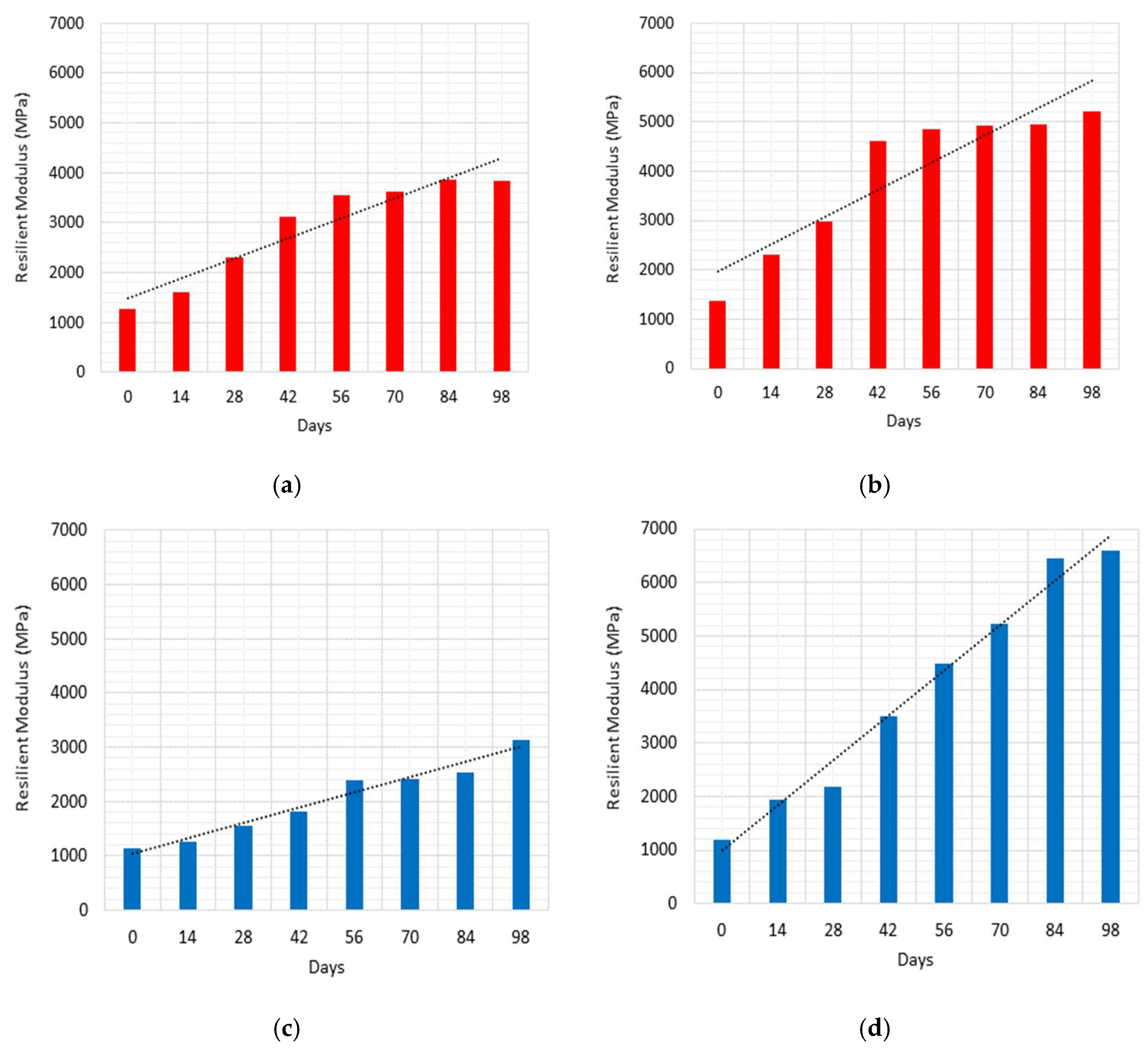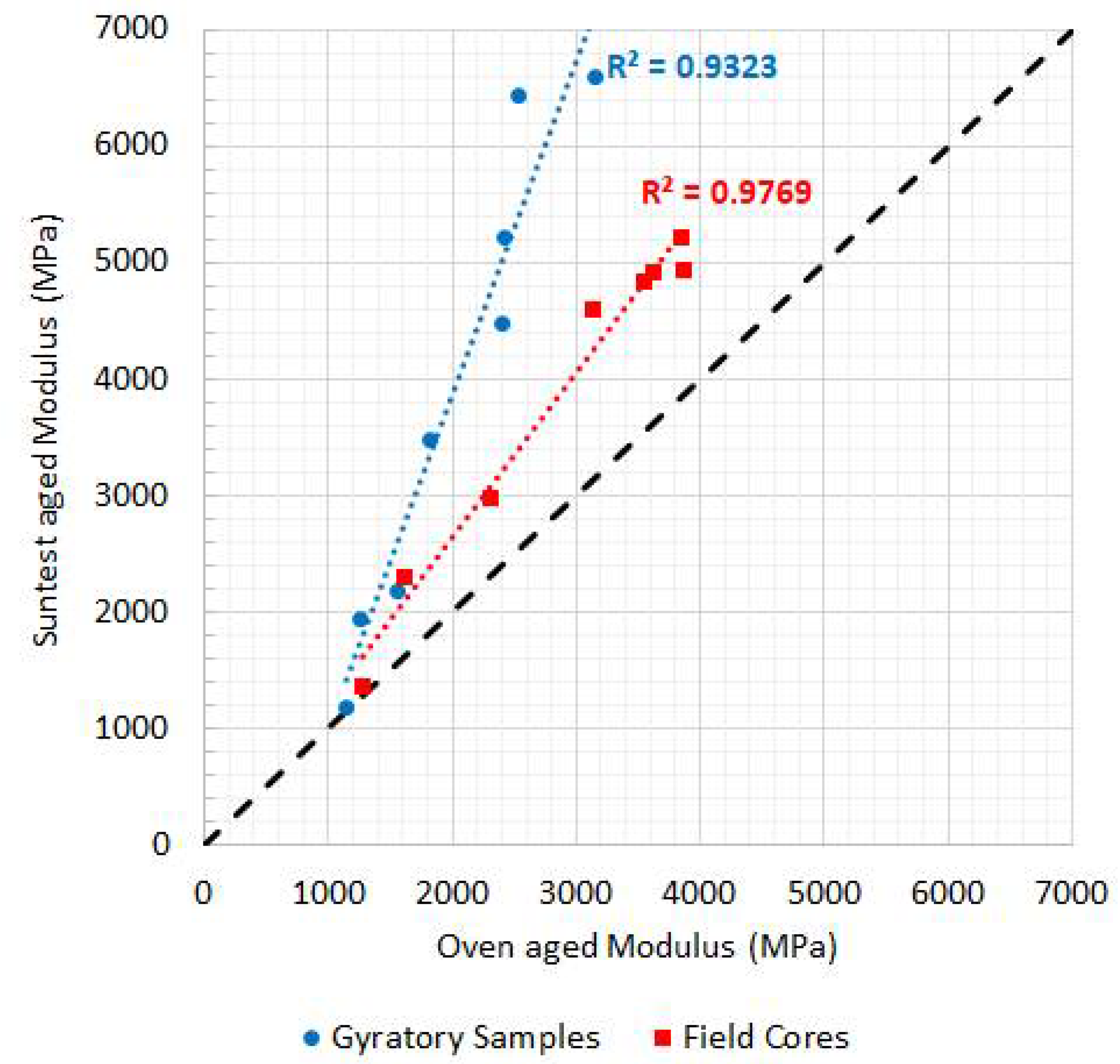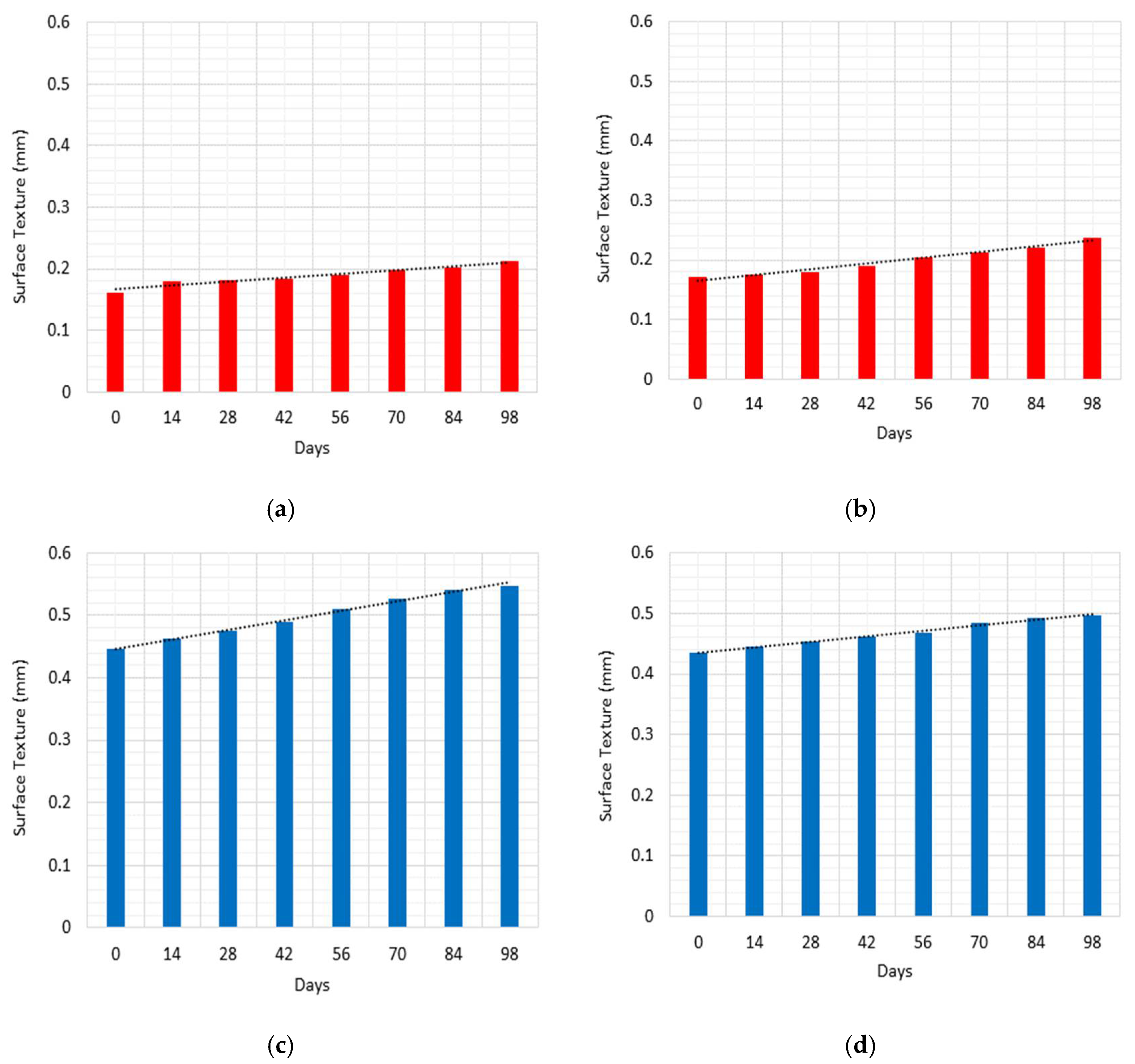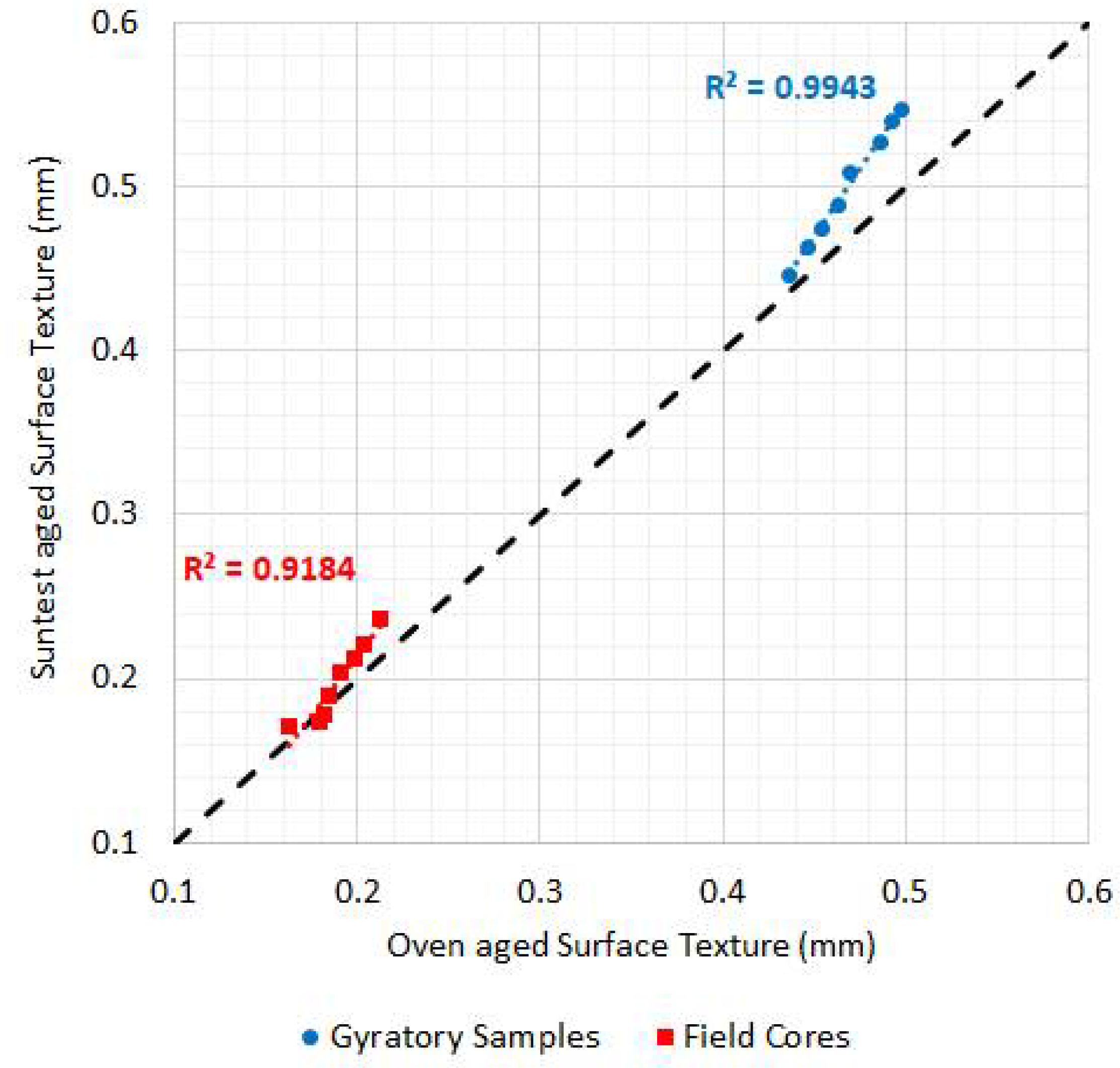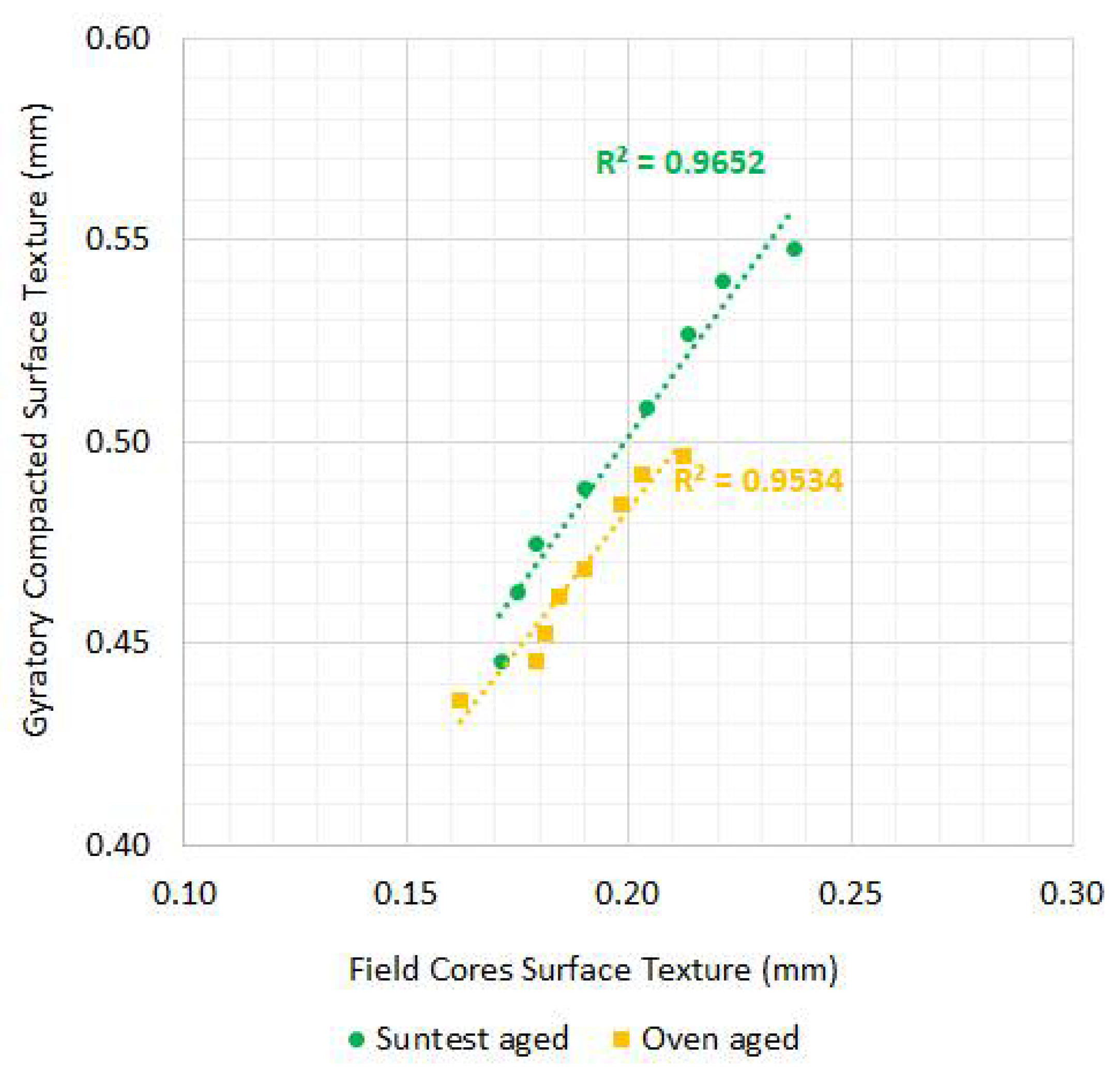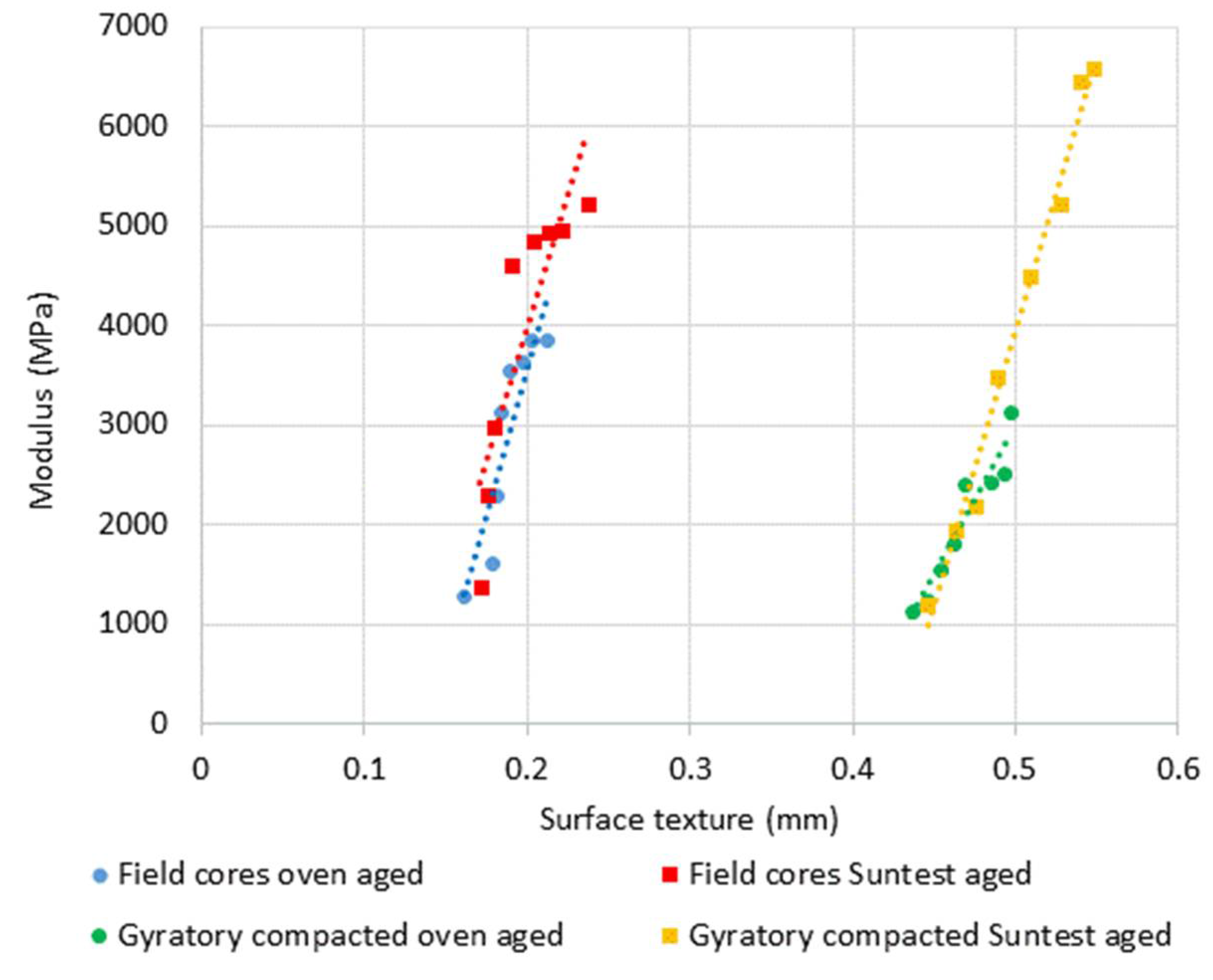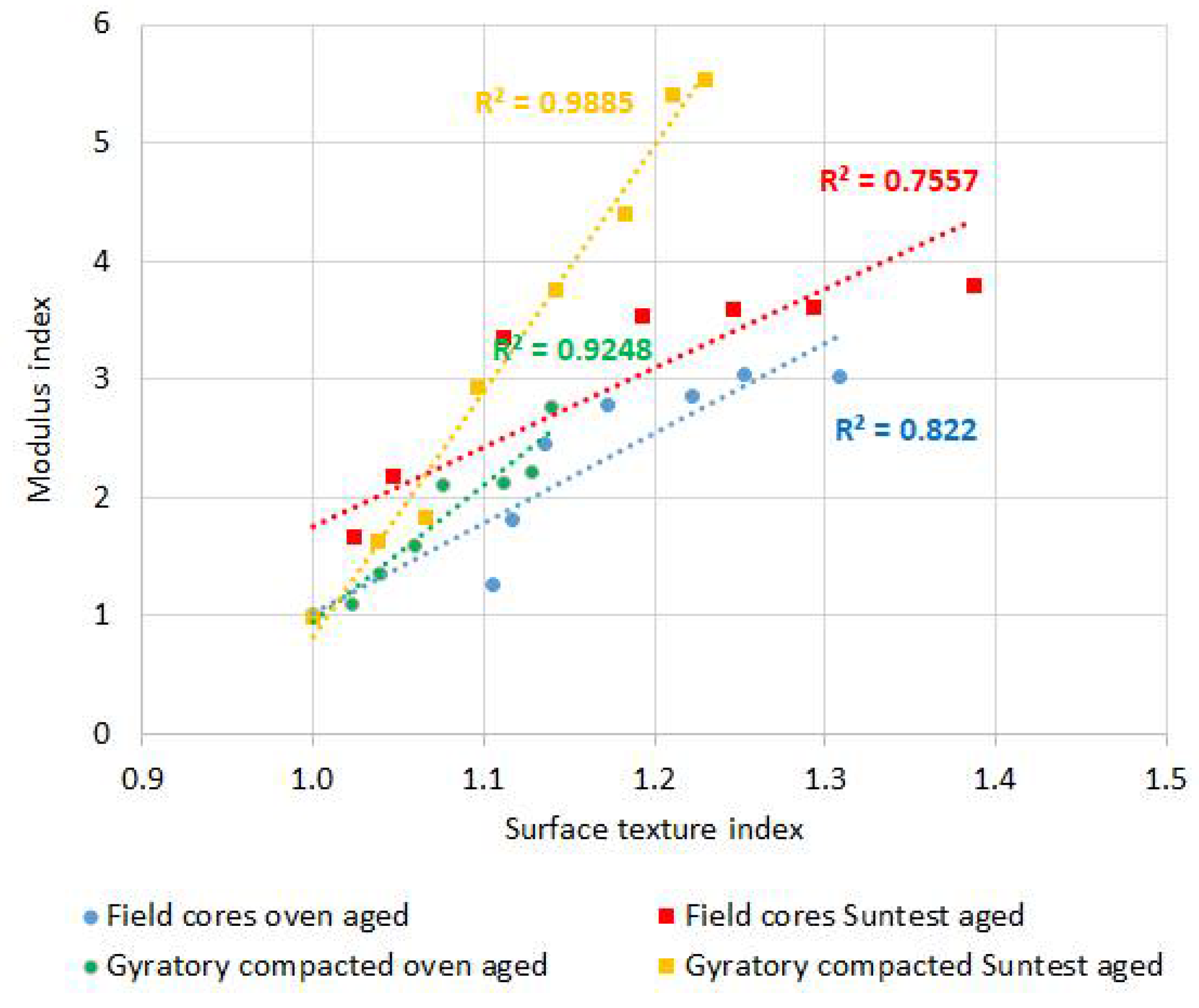1. Introduction
Flexible pavements with asphalt surfaces dominate highway and airport pavement construction. Each year, billions of dollars are spent by the asphalt pavement industry; hence, providing durable asphalt surfaces is critical to providing cost-effective and sustainable flexible pavement structures. The properties of asphalt mixtures are greatly affected by any changes in the rheological properties or chemical composition of the bituminous binder with time, a phenomenon known as bitumen aging [
1]. In recognition of the increased interest in sustainable asphalt mixtures and asphalt preservation treatments for longer-lasting surfaces, developing reliable procedures to simulate the aging of bituminous binders and asphalt mixtures in the laboratory has become increasingly important. The oven-based mixture aging process detailed in AASHTO R30 is the only accelerated laboratory aging protocol for compacted asphalt mixture specimens. It requires samples to be stored at 85 °C for five days, which is intended to reflect ten years of field aging [
2]. However, this process is relatively simple and was developed based on only limited field aging data [
3]. Consequently, it has been questioned by researchers for two primary reasons. First, the single time-temperature combination may not be applicable to different climatic conditions [
3,
4]. Second, applying only heat is not representative of other environmental factors, including ultraviolet (UV) irradiation, which is a catalyst for the oxidation process that causes the aging of asphalt mixtures [
5].
In the field, bituminous binder aging has two aspects: thermal-oxidative aging, which is mainly caused by heat and oxygen [
6,
7,
8], and photo-oxidative aging, which is caused by UV irradiation and oxygen [
9]. Both heat and UV can degrade bitumen properties, but their effects on bitumen aging are different [
5]. A more complicated aging behaviour is noticed when heat and UV irradiation are combined [
10]. Moreover, the aging effect is found to be more severe near the top layer of the asphalt layer compared to deeper in the layer or layers [
11,
12], which is a phenomenon known as the aging profile. This aging profile is not represented in simple thermal-oxidative aging processes because the heat is applied evenly to all faces of the sample. Similar to oven-based mixture testing, some bituminous binder aging studies have found that the standard rolling thin film oven (RTFO) and pressure aging vessel (PAV) protocols do not sufficiently replicate the intended 7–10 years of field aging [
13].
Numerous studies have investigated the effect of UV irradiation on the rheological properties of bituminous binder samples, with a significant conclusion being the preference for UV exposure during accelerated laboratory aging rather than simple thermal aging in a conventional oven. Menapace et al. [
14] found that an accelerated weathering chamber that combines UV irradiation and heat caused more severe chemical changes compared to the standard RTFO/PAV method. In addition, the samples aged in the weathering chamber showed variations in chemical composition between the surface and deeper layers, which demonstrated the gradient of aging with depth, also known as the aging profile. Kuang et al. [
15] confirmed this finding and concluded that thermal and UV aging have distinctly different effects on aging behaviour.
Many other studies have also demonstrated the severe effect of UV irradiation on the rheological properties of bituminous binder samples [
16,
17,
18,
19]. Unlike the bituminous binder studies, the investigation of UV irradiation on the properties of compacted asphalt mixtures is limited.
The aim of this research was to compare the effect of thermal aging in a conventional oven to the combined effect of heat and UV irradiation in an accelerated weather chamber on the properties of compacted asphalt mixtures. Triplicate asphalt samples were compacted with a pneumatic tyre roller, and cores were recovered from the resulting pavement surface, while other samples of the same asphalt mixture were compacted in a gyratory compactor in the laboratory. Half of each type of sample was aged in a conventional dry oven, and the other halves were aged in a commercial weathering chamber. Potential indicators of aging, namely resilient modulus and surface macrotexture, were measured every 14 days, up to 98 days of total accelerated aging time. The 14-day testing interval was selected to allow measurable changes to occur between each test cycle, while the 98-day total aging time was selected to exceed the equivalent of any typical surface life in the field, ensuring that future comparisons to field aging would be interpolated rather than extrapolated.
2. Materials and Methods
2.1. Materials
Six dense graded asphalt (DGA) cores were recovered as part of a runway resurfacing at Emerald airport, located approximately 5 km south of the town of Emerald in the Central Highlands region of Queensland in Australia [
20]. The surface was designed to be a nominal, 14 mm-sized, densely-graded mixture for runway surfacing [
21] with a volumetric composition meeting the Australian airport asphalt specification requirements [
22], as summarised in
Table 1. A highly polymer (SBS) modified binder, known as A10E, was used, with properties summarized in
Table 2. In addition, a bulk sample of the same asphalt mixture was obtained from the Emerald airport resurfacing project, and six specimens were compacted in the laboratory using a Superpave gyratory compactor to obtain the same mixture volumetrics and air voids content. The recovered cores were intended to represent the actual surface of the newly constructed pavements and have been used in this study to be aged in different weathering environments. Three cores of each type of asphalt sample, field cores, and gyratory-compacted samples, were aged in a conventional oven at 70 °C. The other three cores of each type were aged at the same temperature, in combination with UV irradiation in a weathering chamber, to understand the effects of UV irradiation as a catalyst for bitumen aging.
2.2. Aging Procedures
An Atlas Suntest XXL accelerated weathering chamber, as shown in
Figure 1a, was used to simulate the combined effects of UV and temperature aging. Unlike most weathering chambers, the Suntest uses xenon lamps to simulate sunlight according to the CIE85 reference sun, with an irradiance range of 30–65 w/m
2 and control of irradiance wavelengths of either 300–400 nm range or a 340 nm single wavelength [
23]. The advantage of using xenon lamps over traditional fluorescent lamps is that they provide a more realistic simulation of the sun across a wide range of wavelengths compared to traditional fluorescent lamps [
24], as shown in
Figure 1b. Li et al. [
23] studied the effect of UV wavelengths on asphalt mixtures and concluded that each UV wavelength has a distinct effect on the chemical and physical properties of the bituminous binder under otherwise identical aging conditions.
The weathering test conditions are summarised in
Table 3, which has taken into consideration coverage of a wide range of UV wavelengths from 300–400 nm to provide the most realistic conditions possible. The irradiance was set to 50 w/m
2, generating 4.32 MJ/m
2/day of total irradiance exposure.
The thermally aged specimens were placed in a conventional dry laboratory oven. The oven was also set to 70 °C so that the only difference between the oven aging and the weathering chamber aging was the inclusion of UV irradiation. Although 70 °C is lower than the 85C recommended by AASHTO [
2], the total aging duration of 98 days ensured that the total thermal loading significantly exceeded that recommended by AASHTO to represent ten years of field aging.
Every 14 days during the 98-day accelerated aging period, all asphalt mixture samples were removed from their respective environments, allowed to cool to ambient temperature, and tested. Following the modulus and surface texture testing, the samples were returned to their respective aging environments.
2.3. Resilient Modulus Testing
Asphalt mixtures harden with age due to bituminous binder volatile loss during construction, as well as progressive oxidation throughout the service life. This increases the binder viscosity and consequently stiffens the asphalt mixture [
25]. Resilient modulus is one of the design inputs of the mechanistic-empirical design method used in many countries and is considered one of the common indicators of asphalt aging. Idham et al. [
26] investigated the effect of aging using long-term oven aging (LTOA) for five days at 85°C on the resilient modulus of DGA samples and concluded that resilient modulus increased 10% to 23% with age, depending on mixture type and gradation.
In this study, a UTM-14P, shown in
Figure 2, was used to measure the resilient modulus according to Australian standard AS 2891 [
27], where a repeated indirect tensile load is applied to determine the resilient modulus.
Figure 2 shows the vertical load cell that applies compressive haversine load pulses to the sample platen, which induces indirect tensile stress in the asphalt sample. The linear variable differential transformers are also shown, and these measure the resulting horizontal diametrical strain across the sample. The test temperature was set to 25 °C, as required by the Australian standard.
2.4. Surface Texture Measurement
Most previous studies discuss the role of binder aging on fatigue and low-temperature cracking. However, some recent studies revealed how aging also affects the surface macrotexture, skid resistance, and ravelling of asphalt mixtures. Kane et al. [
28] investigated the friction coefficient for asphalt specimens extracted from un-trafficked parts of road pavements and found that it increased with time, indicating that asphalt aging is a factor affecting surface roughness. Furthermore, Abouelsaad & White [
29] measured the surface macrotexture of trafficked and untrafficked areas of runways and taxiways, concluding that aircraft trafficking had no significant effect on surface texture, which is an indicator of ravelling, confirming that the major cause of airport pavement surface ravelling is age-related binder weathering. Van de Ven et al. [
30] also investigated the possible causes of ravelling in porous asphalt concrete and highlighted that aging adversely affected the cohesive characteristics of the bituminous mortar, leading to particle loss with time.
In this study, asphalt surface texture was measured using the sand patch test, as shown in
Figure 3, according to ASTM E 965, adjusted to measure the macrotexture depth of the extracted cores, rather than an infinitely large surface. The mean texture depth (MTD) was calculated according to Equation (1).
where:
By comparing
Figure 3a1 to
Figure 3b1, the difference between the field-compacted and gyratory-compacted samples can be seen. Similarly, the distribution of the spread sand can be seen in
Figure 3b1,b2.
2.5. Analysis of Results
The test results were analysed using a combination of visual presentation and basic statistics. Visual presentation included figures of the modulus and surface texture as a function of accelerated aging time, as well as comparison of results for different sample preparations and aging protocols. The basic statistics included mean, standard deviation, and coefficient of variability, as well as Student’s t-tests for the difference in means and the slope of regression lines. In all statistical tests, a p-value less than 0.05 was considered to indicate a significant difference between the populations being compared, or a non-zero linear regression gradient.
3. Results and Discussion
3.1. Modulus and Texture Results
The resilient modulus results for the recovered field cores are summarized in
Table 4, while the resilient modulus results for the gyratory-compacted samples are in
Table 5. The surface texture test results for recovered field cores are summarized in
Table 6, while the surface texture results for the gyratory-compacted samples are in
Table 7.
3.2. Variability of Results
Table 8 and
Table 9 summarize the average resilient modulus values, standard deviations (SD), and coefficients of variation (CoV) for the field cores and gyratory-compacted samples, respectively. The average CoVs of the resilient modulus for the field cores were 9% and 4% for oven-aged samples and Suntest-aged samples, respectively, while the average CoVs of the gyratory-compacted samples were 12% and 7%. For both the field cores and the gyratory-compacted samples, the resilient modulus was less variable for the Suntest-aged samples than for the samples aged in the oven. Furthermore,
Table 10 and
Table 11 summarize the average mean texture depths, SD, and CoV values of the field cores and gyratory-compacted samples, respectively. For the field cores, the average CoVs were 6% and 8% for the oven-aged samples and Suntest-aged samples, respectively. Furthermore, the average CoVs of the surface texture for the gyratory-compacted samples were 22% and 6%, which shows less variation in the surface texture results for samples that were aged in the Suntest compared to samples aged in the oven.
In any research, results with low variability are preferred because any measured differences in the average value of the results are more likely to be statistically significant, and therefore meaningful. For the modulus values, the Suntest-aged samples were generally associated with lower variability than the oven-aged samples. Furthermore, the variability of the gyratory-compacted samples was comparable to the variability of the field cores. In contrast, the variabilities of all the surface texture results were generally comparable, except for the gyratory-compacted samples aged in the oven. However, this was likely to be an anomaly. Consequently, the convenience of gyratory-compacted samples is expected to outweigh the more realistic nature of field cores as long as modulus is used as the indicator of asphalt aging. The reduced variability associated with the Suntest-aged samples is also beneficial for future research.
3.3. Effect of Aging on Resilient Modulus
As stated above, as the binder ages, it stiffens, and the asphalt mixture modulus increases.
Figure 4 shows the average resilient modulus of both the field cores and gyratory-compacted samples. There is a clear and positive correlation between aging time and modulus for all samples, with a significantly higher rate of modulus increase associated with the gyratory-compacted samples aged in the UV chamber. In addition, the strength of the correlation, indicated by the R
2 values, was greater for the gyratory-compacted samples compared to field cores. This likely reflects the lower variability associated with the gyratory-compacted sample modulus. On average, the initial modulus of the field cores was 12% higher than for the gyratory-compacted samples, and this difference was statistically significant (
p-value 0.02). This reflects the more rapid cooling and short duration of reheating for the gyratory-compacted samples compared to the hot storage and haulage time for field core samples. Consequently, an index, based on the ratio of the aged modulus to the initial (unaged) modulus is recommended in the future.
It is also clear that the field core samples were associated with a reducing increase in modulus with accelerated aging duration, indicated by the flattening of the results after approximately 42 days of aging. This was likely the result of micro-damage caused to the samples due to repeated colling, modulus testing, and heating cycles. The same damage was not observed in the gyratory-compacted samples, allowing the modulus to continue to increase steadily with accelerated aging duration. As a result, the difference between oven- and Suntest-aged sample modulus was greater for the gyratory-compacted samples than it was for the field cores.
Figure 5 shows the resilient modulus of oven samples versus UV samples, presented around a line of equity. All points are located above the line of equity, which indicates that the combined effect of heat and UV irradiation resulted in greater increases in resilient modulus, compared to samples that were aged in the oven, at all aging times. The combined effect of heat and UV irradiation showed higher resilient moduli values, with a total increase percentage from initial values of 280% and 478% for field samples and gyratory-compacted samples, respectively. In comparison, the corresponding increases for the samples aged in the oven were 203% and 175%. By using linear interpolation based on resilient modulus, it was found that 98 days of oven aging was equivalent to 35 and 38 days of Suntest aging for field cores and gyratory-compacted samples, respectively. The differences in the modulus after the oven and Suntest aging were significant, with paired
p-values <0.01 for both the field core samples and the gyratory-compacted samples.
3.4. Effect of Aging on Surface Texture
Figure 6 shows the average surface texture of both field cores and gyratory-compacted samples. The surface texture increased with aging duration for all samples, with a significantly higher rate of increase for gyratory-compacted samples that have been aged in the UV chamber. The results showed that the gyratory-compacted samples had a higher initial surface texture than the field cores, with averages of 0.43 mm and 0.17 mm, respectively (
p-value < 0.01). The field core samples had a lower initial and aged surface texture than is normally expected in the field, where initial textures are typically 0.4 mm to 0.6 mm, and end-of-life surface textures are typically 1.0 mm to 2.0 mm [
19]. This likely reflects the concentration of pneumatic tyre rolling that the surface, from which the field cores were extracted, was subjected to during on-site compaction. This was because the asphalt layer from which the cores were recovered was specifically constructed for the purpose of recovering cores rather than being part of the Emerald airport runway resurfacing work. As a result, the cores were not representative of normal airport pavement construction and rolling practices.
The significant difference in initial surface texture makes direct comparison of the field cores and gyratory compacted samples challenging. However, the relative change in surface texture is a better indicator of asphalt aging than the absolute value of surface texture at any given time. This demonstrates the importance of aging indices, which normalize any differences in the initial values, as demonstrated below.
Figure 7 shows the average surface texture depth of oven-aged samples, compared to that of the Suntest-aged samples, along with a line of equity. The distribution of points above the line of equity indicates the more noticeable effect of the combined heat and UV irradiation of the Suntest weathering chamber on the surface texture, compared to samples that were aged in the oven.
After 98 days of aging in the weathering chamber, surface texture increased by 39% and 23% for field cores and gyratory compacted samples, respectively. For the oven-aged samples, the increases were 31% and 19% for the field cores and the gyratory-compacted samples, respectively. Before aging, there was no significant difference between the surface texture of the oven and Suntest samples (p-value > 0.5). Furthermore, after aging, there remained no significant difference between the oven and UV sample surface textures, with p-values of 0.34 and 0.06 for the field core samples and the gyratory-compacted samples, respectively. This indicates that the difference between the oven aging and the more realistic Suntest aging had no significant effect on the surface texture, despite having a significant effect on the mixture modulus values. From this, it was concluded that other factors, such as wind and rain, must also contribute to age-related asphalt mastic erosion and ravelling. This means that despite being an improvement over conventional oven aging, the Suntest weathering chamber still does not reflect field aging of asphalt surfaces, at least with regard to surface texture changes.
3.5. Field Cores Compared to Gyratory Compacted Samples
Figure 8 shows the relationship between resilient modulus and surface texture of the field cores and gyratory-compacted samples at different ages. The resilient modulus results are distributed close to the line of equity, indicating there was no significant difference between the modulus of the two sample types (
p-value > 0.5). In contrast, the average surface texture results are scattered away from the line of equity, indicating a large difference in the mean texture depth of the field cores and the gyratory-compacted samples (
p-value < 0.01).
As explained above, the difference in the aged surface texture results was also reflected in the initial surface texture values, so it is not attributable to a difference in the effect of accelerated aging on the two sample types. Rather, it reflects the construction of the surface from which the field cores were recovered, which was not representative of normal construction practices. In contrast, the gyratory-compacted samples, despite being prepared in the laboratory, had a surface texture that was comparable to common airport surfaces.
Figure 9 shows the same data with the axes adjusted, and the correlation between the field core and gyratory-compacted surface textures is high, with R
2 values of 0.95 and 0.97, for the oven-aged and Suntest-aged samples, respectively. This indicates that the inclusion of UV radiation in the Suntest weathering chamber did not significantly change the rate of surface texture increase with aging duration compared to the oven-aged samples. Consequently, it was concluded that factors other than UV radiation are important for achieving more realistic laboratory aging of asphalt surfaces, at least with regard to the evolution of surface texture over the life of a runway surface.
3.6. Comparison of Indicators
Two potential indicators of aging were measured at each age, namely the modulus and the surface texture.
Figure 10 shows the relationship between the average resilient modulus and the average surface texture depth for all samples. A strong correlation between surface texture and modulus is clear; however, the correlation was stronger for the gyratory-compacted samples.
As explained above, the increase in sample modulus with age was generally consistent with the field observations reported by other researchers [
26]. However, the initial field core surface texture was not consistent with typical airport surface construction, and neither the field cores nor the gyratory-compacted samples had a surface texture that was consistent with an end-of-life asphalt surface even after 98 days of accelerated aging [
20]. This indicates that neither the Suntest weathering chamber nor the conventional oven caused surface mastic erosion and fretting that was representative of field aging over 10 years.
The two indicators of asphalt aging were converted to index values by dividing each aged test value by the initial unaged value. This allowed both the modulus and surface texture indices to be graphed coincidentally, as shown in
Figure 11. The gyratory-compacted samples had a stronger correlation between surface texture and modulus, with R
2 values of 0.92 and 0.99 for the oven-aged and Suntest-aged samples respectively, compared to the 0.82 and 0.76 values for the field core samples. This again indicates that the reduced variability associated with the gyratory-compacted samples suggests that future research should focus on these laboratory-prepared specimens rather than the field cores.
The strong correlation between the average resilient modulus and average surface texture depth supports the hypothesis of ravelling being caused by a loss of mastic bridges due to mixture stiffness, as a result of environmental factors including UV irradiation and heat [
23,
26]. However, the modulus is a better indicator of accelerated laboratory aging because the results are more representative of field aging than the surface texture results.
